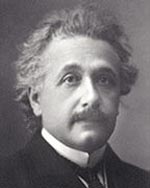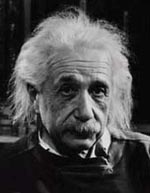Tales of Statisticians
Albert Einstein
14 Mar 1879 - 18 Apr 1955Einstein was not comfortable with statistical reality, a shortcoming which cost him much happiness, and may have deprived the world of many discoveries.
His youthful breakthrough is well known. It consisted not only in giving the equation linking mass and energy (the famous e = mc²), but in showing the statistical nature of quantum mechanics. Few meteors have more memorably decorated the mathematical sky.
He began working in the Swiss Patent Office in 1902. In 1905, his "annus mirabilis," he submitted to Annalen der Physik fundamentally important papers on light quanta (March), molecular dimensions (April), the statistical analysis of Brownian movement (May), the special theory of relativity and the space-time continuum (June), and the famous equivalence between mass and energy (September). In 1909 he left the Patent Office for a modest academic post in Switzerland. In 1915, he published a more general theory of relativity, and in 1917 (relying on work done in 1911) a paper which predicted the amount by which light would be bent in a gravitational field. The solar eclipse of 29 May 1919, observed at the end of WW1 by a British team, showed that Einstein's prediction was closely fulfilled. That eclipse was for him what the orbit of Ceres had earlier been for Gauss. Nature had done what he had predicted it would do. He won the Nobel Prize in 1921.

Scarcely less well known than Einstein's leadership in relativity theory is his renunciation of that leadership, due to his revulsion at the "statistical" nature of the reality which his own discoveries suggested. The Solvay Conferences had been one of his major forums. But at the 5th Conference in 1927, he read no paper, and was silent except for objecting to the statistical implications of the papers by Bohr and Heisenberg. It grieved him to find chance at the heart of nature. The dictum of his renunciation was "the good God does not play dice with the universe." In the days of his glory, like Laplace, he had had "no need" of a God hypothesis. Now, that hypothesis crowded in upon him.
He began in 1928 to seek a unified field theory that would explain nature at a deeper level, and restore a sense of purpose to the universe. The comment of Max Born at this time has lost none of its poignancy: "Many of us regard this as a tragedy, both for him, as he gropes his way in loneliness, and for us, who miss our leader and standard bearer." His unified field theory, published in 1929, was not warmly received. A second "annus mirabilis" of physics occurred in 1932. But it did not happen to Einstein. It consisted of three laboratory events: the discovery of the neutron by Chadwick, the discovery of the positron by Anderson, and the first artificial disintegration of the atomic nucleus by Cockcroft and Walton. All this gave further impetus to the theory and application of the new physics. Einstein's isolation from the future of his subject was complete.

His long last years (1933-1955) were spent fruitlessly at the Institute for Advanced Study, whose reputation he nevertheless made. Those years were spent in a continued search for the unified field theory. A revised version published in 1950 aroused no response, other than embarrassment, from the scientific community.
The universe does indeed play dice with men. At least Pascal, the philosopher of dice, bravely grasped his chance of winning. Einstein took one long anguished look, and walked out of the casino.
What good is brain, if not seconded by nerve?
Statistics is Copyright © 2001- by E Bruce Brooks
4 Sept 2004 / Contact The Project / Exit to Statistics Page